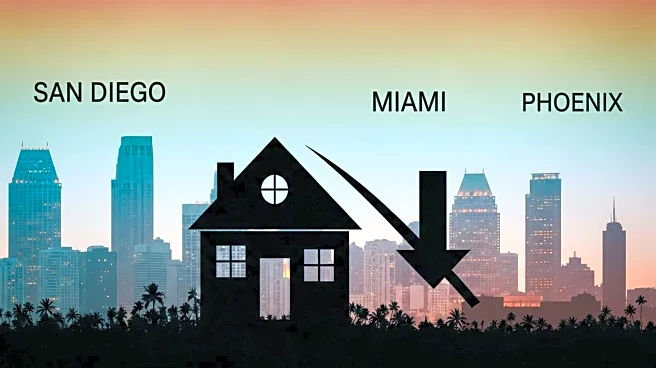What is the story about?
What's Happening?
Home values in San Diego, Miami, and Phoenix have experienced annual declines in sales prices for single-family homes as of June, according to the S&P CoreLogic Case-Shiller Index. This trend adds these cities to a list of seven major metros in the South and West where home values are falling, including Dallas, Denver, San Francisco, and Tampa. Nationally, home values rose by 1.9% in June compared to the previous year, marking the slowest annual growth since July 2023. However, there is a stark regional divergence, with prices rising in the Northeast and Midwest while declining in the South and West. New York reported the highest annual gain among the 20 cities tracked, with a 7% increase, followed by Chicago and Cleveland. The downturn in San Diego is particularly notable, as the city had previously seen rapid price growth.
Why It's Important?
The decline in home values in these cities reflects broader affordability constraints and uneven regional demand in the U.S. housing market. This trend could impact homeowners and potential buyers, as wages are beginning to catch up with home prices, potentially making housing more accessible. The shift from rapid price growth to more stable conditions may signal a healthier long-term trajectory for the housing market, aligning more closely with economic fundamentals rather than speculative excess. This adjustment could affect real estate investments and the overall economic landscape, as housing wealth has declined in inflation-adjusted terms over the past year.
What's Next?
As the housing market adjusts, stakeholders such as real estate investors, homeowners, and policymakers will likely monitor these trends closely. The maturation of the housing cycle may lead to more stable growth aligned with inflation, impacting future real estate strategies and economic policies. Builders in high-supply markets may continue to offer incentives and price cuts, influencing resale values. Additionally, the ongoing regional divergence in home values may prompt further analysis and adjustments in housing policies to address affordability and demand disparities.
Beyond the Headlines
The decline in home values in these cities may have deeper implications for local economies and communities. As wages catch up with home prices, there could be shifts in demographic patterns, with potential impacts on local businesses and services. The adjustment in housing wealth may also influence consumer spending and broader economic activity, as homeowners reassess their financial positions. Furthermore, the regional disparities in housing trends may highlight underlying economic and social factors that require attention from policymakers and community leaders.
AI Generated Content
Do you find this article useful?













